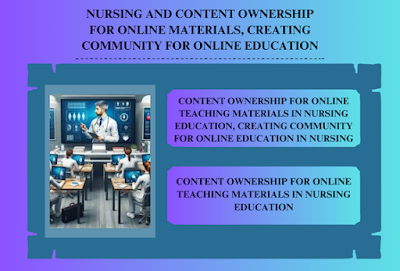The Content Ownership for Online Materials Creating Community for Online Education In Nursing. When students feel they belong to a classroom community, they are more likely to be motivated to complete their assignments, feel confident enough to participate in discussions, and are open to feedback that helps them improve.
The Content Ownership for Online Materials Creating Community for Online Education In Nursing
In the context of online nursing education, understanding content ownership and fostering a sense of community are critical to successful and engaging learning experiences. While the exact details of content ownership may vary, they generally refer to who owns the intellectual property rights to online materials, such as course content, assignments, and discussions. A strong community where students feel comfortable sharing and collaborating can improve learning and retention.
A sense of community is created through online communication, participation, and relationship building. Instructors address the class in general terms. Instructors communicate individually with students and engage them through thought-provoking questions.
Technology has significantly simplified the duplication, distribution, and display of copyrighted material. However, the ease of these processes does not equate to legality. Faculty, librarians, and developers must be well-versed in the laws governing the use of copyrighted material in online courses (Baeslack et al., 2013).
Understanding Intellectual Property Types
Intellectual property comprises four main types: copyright, trademark, patent, and trade secret. In the context of online courses, copyright law plays a pivotal role, as it covers the rights to duplicate, distribute, derive, display, and perform content in digital or telecommunication formats (Tillman, 2008). Copyright protection applies to the expression of an idea, such as a video or written work, rather than the idea itself.
Navigating Copyright and Fair Use in Education
To avoid copyright infringement, educators can transform the presentation of ideas. Educational institutions benefit from a Fair Use Exemption, which allows for the reasonable use of copyrighted materials under certain conditions (Tillman, 2008). When determining the applicability of this exemption, four factors are considered, with market effect favoring nonprofit institutions over for-profit entities.
The Face-to-Face Teaching Exemption and TEACH Act
The Face-to-Face Teaching Exemption and TEACH Act permit nonprofit educational institutions to digitally transmit copyrighted works, provided the amount transmitted is similar to what would be displayed in a physical classroom and other conditions are met. It is crucial for both faculty and students to be aware of copyright laws to avoid violations (Tillman, 2008).
Obtaining Permission and Managing Costs
Permission to use copyrighted material can be acquired from the copyright holder. Some agreements may require acknowledging the owner’s name and copyright status, while others may involve payment. Institutions may opt for a one-time fee over ongoing royalties to avoid the complexities of tracking and accounting.
Addressing the “Last Mile” Problem in Online Education
The “last mile” problem in telecommunications, which pertains to connecting homes and businesses to technology, has been largely resolved for online learners through access points like local libraries. However, a different “last mile” problem exists related to knowledge access, as online education transitions from print to electronic formats. Despite easier technological access, financial costs associated with quality resources remain a challenge (Suber, 2008).
Government Initiatives and Open Access
To address resource access issues, the federal government has promoted open access to the results of federally funded research, requiring publication without charge within one year of peer-reviewed journal publication (Stebbins, 2013). While this benefits public access, it may impact scholarly publishing by reducing publisher revenue.
Ownership of Content in Online Courses
Online courses typically involve content created by faculty, third parties, and educational institutions. Ownership depends on contracts, licensing agreements, and intellectual property laws. Traditionally, online course content belongs to the institution offering the course, while students retain ownership of their contributions, such as papers and discussion posts.
MOOCs and Content Ownership
Massive Open Online Courses (MOOCs) often include disclaimers that submissions waive all rights to the content, allowing hosting, displaying, reproducing, modifying, distributing, and relicensing by the course provider. Platforms like Coursera, edX, and Udacity introduce a fourth stakeholder in content ownership (Baeslack et al., 2013).
Creating Community for Online Education in Nursing
Overcoming the Absence of Face-to-Face Interaction
The lack of face-to-face communication in online education necessitates specific strategies to foster a connected learning environment. Educators should employ activities that promote personal interaction and allow students to get to know each other before diving into course content.
Building an Engaging Online Learning Community
At the start of each course, educators can create a learning community through activities like sharing pictures, engaging in icebreaker activities, and posting introductory messages. Sharing personal information, such as photographs or video introductions, can help students connect with faculty.
Utilizing Discussion Forums and Interaction
Establishing discussion forums where students can ask questions and engage in dialogue without faculty presence can enhance the sense of community. While some faculty may opt for periodic face-to-face interactions, a robust online learning community can thrive without physical meetings.
Content Ownership for Online Materials Creating Community for Online Education In Nursing
Content Ownership for Online Materials Creating Community for Online Education In Nursing
Content Ownership for Online Materials Creating Community for Online Education In Nursing
Read More:
https://nurseseducator.com/didactic-and-dialectic-teaching-rationale-for-team-based-learning/
https://nurseseducator.com/high-fidelity-simulation-use-in-nursing-education/
First NCLEX Exam Center In Pakistan From Lahore (Mall of Lahore) to the Global Nursing
Categories of Journals: W, X, Y and Z Category Journal In Nursing Education
AI in Healthcare Content Creation: A Double-Edged Sword and Scary
Social Links:
https://www.facebook.com/nurseseducator/
https://www.instagram.com/nurseseducator/
https://www.pinterest.com/NursesEducator/
https://www.linkedin.com/in/nurseseducator/
https://www.researchgate.net/profile/Afza-Lal-Din
https://scholar.google.com/citations?hl=en&user=F0XY9vQAAAAJ
